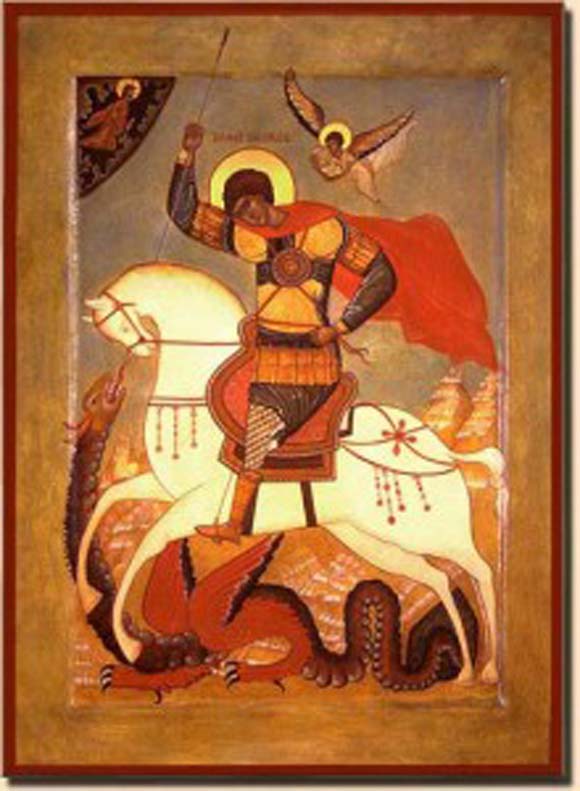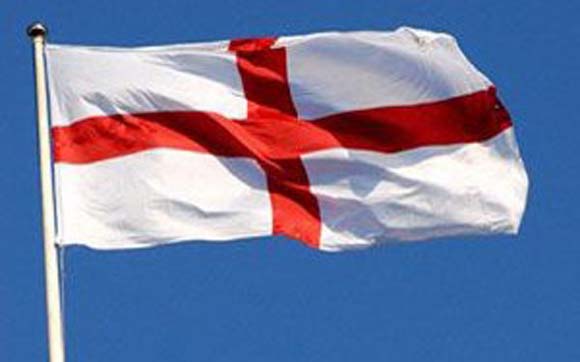
Saints This Month-23 April: St. George
986
 One of the most interesting social trends in my life has been the rebirth of England as a distinct cultural entity in the United Kingdom. It was only in the mid 1990s that the St. George’s Cross began to be seen across the country, especially during sporting events. Previously the English flag had only been seen at Anglican Churches, on admiral’s ships and at far-right rallies. If an Englishman wished to be patriotic, the Union Flag was his banner of choice. Now all of this could be caused by the shrewd marketing of sportswear companies or the devolved government in Scotland and Wales, but nevertheless this rise in English nationalism has also given a renewed interest in the feast of St George and its celebration.
One of the most interesting social trends in my life has been the rebirth of England as a distinct cultural entity in the United Kingdom. It was only in the mid 1990s that the St. George’s Cross began to be seen across the country, especially during sporting events. Previously the English flag had only been seen at Anglican Churches, on admiral’s ships and at far-right rallies. If an Englishman wished to be patriotic, the Union Flag was his banner of choice. Now all of this could be caused by the shrewd marketing of sportswear companies or the devolved government in Scotland and Wales, but nevertheless this rise in English nationalism has also given a renewed interest in the feast of St George and its celebration.
St George is one of the most highly celebrating Saints in both the Eastern and Western Churches. Pope Gelasius stated that George was among those saints “whose names are justly reverenced among men, but whose actions are known only to God”, but it is thought that he was born into a noble family in Palestine during the late third century. George went to Nicomedia, to begin a career as a soldier. By his late 20s, George was promoted to the rank of Tribune and stationed as an imperial guard of the Emperor at Nicomedia.
In the year AD 302, Diocletian issued an edict that every Christian soldier in the army should be arrested and every other soldier should offer a sacrifice to the pagan gods. But George objected and with the courage of his faith approached the Emperor. George loudly renounced the Emperor’s edict, and in front of his fellow soldiers and Tribunes he claimed himself to be a Christian and declared his worship of Jesus Christ. Diocletian attempted to convert George, even offering gifts of land, money and slaves if he made a sacrifice to the pagan gods. The Emperor made many offers, but George never accepted. Recognizing the futility of his efforts, Diocletian was left with no choice but to have him executed for his refusal. Before the execution George gave his wealth to the poor and prepared himself. After various torture sessions, including laceration on a wheel of swords in which he was resuscitated three times, George was executed by decapitation before Nicomedia’s city wall, on April 23, 303. Tradition has held that his blood formed a cross.
St. George’s great act of witness, strength and Christian virtue led to him becoming one of the most venerated saints in Palestine. His cult spread throughout the Eastern Church and eventually reached the West in the 5th century. In England the earliest reference is from the will of Alfred the Great but St George’s popularity exploded during the crusades. This soldier saint, born in the Holy Land, was the perfect patron for the crusaders. The legend of Saint George and the Dragon was popularised in this period and it has been suggested that it is an allegory of his status as the protective giant of Christendom and the Faith.

It is a very good thing to celebrate a patron but the problem lies in how and why we celebrate. The modern celebration of the feast has fallen, albeit on a much smaller scale, into the same state as the commercial “Oirish-fest” that St Patrick’s Day has become. This is a terrible shame, as the Christian virtue of St George is the reason behind him being so venerated throughout the world. Wherever St.George is especially celebrated, be it Genoa or Barcelona, Georgia or Portugal, Milan or Malta, or Palestine and England. Let us remember why we venerate him: not because of some nationalistic shindig or a publican’s marketing scheme. We venerate him because of his witness to Christ. He is an example to all of us. This St.George’s Day let us pray for the conversion and protection of England first: then we can have a pint or two of ale in his honour.


